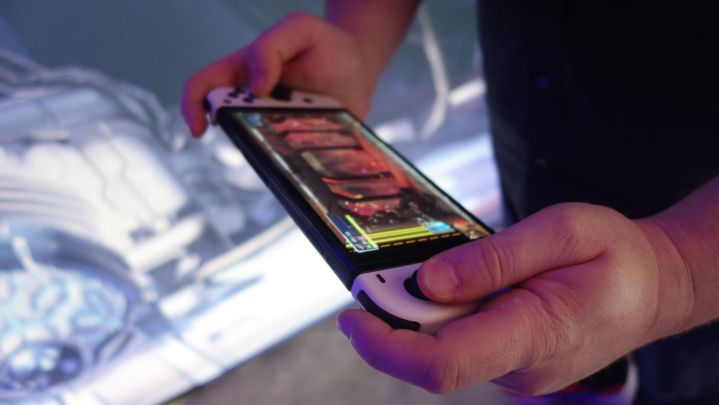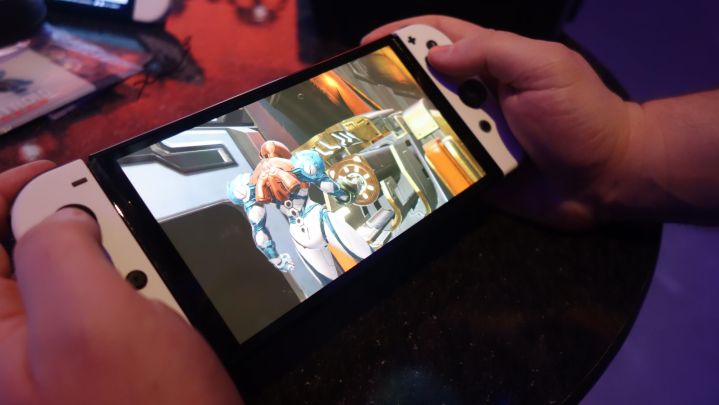When Nintendo announced the Switch OLED model, fans weren’t too happy. Many had anticipated a Switch Pro was coming and had some big (though reasonable) expectations. Many hoped for resolution bumps in both docked and handheld mode. It didn’t help that publications like Bloomberg had been publishing credible reports that further raised those hopes.
Then came the crushing disappointment. The new Switch wouldn’t give Nintendo games a major graphical boost. Instead, it would simply feature an OLED screen that was bigger and brighter than the base Switch’s LCD display. Its other bells and whistles felt like they should have been there all along, like a wired internet port and an adjustable kickstand. We certainly weren’t getting a PS4 Pro-style upgrade here.
Now that the initial frustration has passed, it’s time to focus on what the Switch OLED actually does, rather than what it doesn’t. I went hands-on with Nintendo’s new console, testing it with a demo of Metroid Dread. While I don’t think that the Switch OLED will be a necessary upgrade for most gamers, it’s undoubtedly a better iteration of the console that has me tempted to upgrade.
Incrementally better
At a passing glance, the Switch OLED looks and feels about the same as a base model, save for its white Joy-Cons. But the big difference is in its screen, which explains why Nintendo opted to focus on that in its naming convention, rather than calling it a Pro model. The OLED display is notably bigger than that of a base Switch. The console itself isn’t noticeably larger, but it makes much better use of its real estate.

On a standard Switch, there’s a black frame around the 6.2 inch screen. The OLED minimizes that space, letting the display expand out to seven inches. Every tenth-of-an-inch counts when talking about a mobile gaming device, and I certainly felt a noticeable difference when playing in handheld mode (especially as someone whose vision has started eroding after staring at screens all day during lockdown last year).
More notable, though, is that the screen makes the Switch feel less like a toy and more like a precious piece of tech. The old model’s massive bezel seems a little goofy by comparison when I look at it now. It’s a subtle visual difference, and not one that should convince anyone to upgrade, but I certainly found myself feeling like I wanted to handle the OLED with a bit more care than my original, hairline-scratched Switch.
What really matters is visual quality, and I was instantly impressed by what I saw on the console. No, it doesn’t run 4K graphics in handheld mode as some gamers were clamoring for. However, it does look undoubtedly better. In playing Metroid Dread, colors felt crisp and vibrant. The blue of Samus’ new suit really pops off the screen in a way that it doesn’t on my 2019 model Switch. Dread is a smart game to launch with the console; its heavy focus on atmospheric lighting effects means that you really get a sense of how bright the display can get. The images on my current Switch suddenly felt a little washed out when I sat down with it afterward.

A hard sell
Aside from the new screen, there wasn’t much else to note from my time with the system — and that’s what makes it such a hard sell. The adjustable kickstand is certainly an upgrade, as it allows me to tilt the angle of the Switch to my liking when playing in tabletop mode. That’s a nice upgrade from the current Switch’s flimsy kickstand, which now feels as toy-like as its screen after using the OLED version. The audio is supposedly better in the new model as well, but it was hard to get a sense of that without a direct, back-and-forth comparison between the models. I didn’t get to check out the wired internet connection, either, but I have doubts that it’ll fully fix Nintendo’s deeper online issues anyways.
The decision to upgrade seems like it’ll simply comes down to whether or not you want a bigger, brighter screen when you play. Those who never touch an OLED model will be none the wiser; without a point of comparison, the regular Switch will feel entirely serviceable. But the moment you actually get to see the new panel in action, it’ll retroactively ruin your perception of your trusty console. The screen will look unusually small. The image will seem flatter. The bezel will feel sillier.
I walked into the Switch OLED hands-on feeling like there was a 0% chance I’d pick one up. Now I’m kicking myself for not pre-ordering a thing I very sincerely do not need.
The Nintendo Switch OLED launches on October 8 alongside Metroid Dread.
Editors' Recommendations
- How Zelda: Ocarina of Time speedrunners break the N64 in incredible new ways
- Mario Kart 8 Deluxe has a new Yoshi’s Island track — and it’s perfect
- I’m already pining for PlayStation VR2 to get Half-Life: Alyx
- Grab these Nintendo 3DS games before the eShop closes
- Download these rare Wii U games before they disappear





